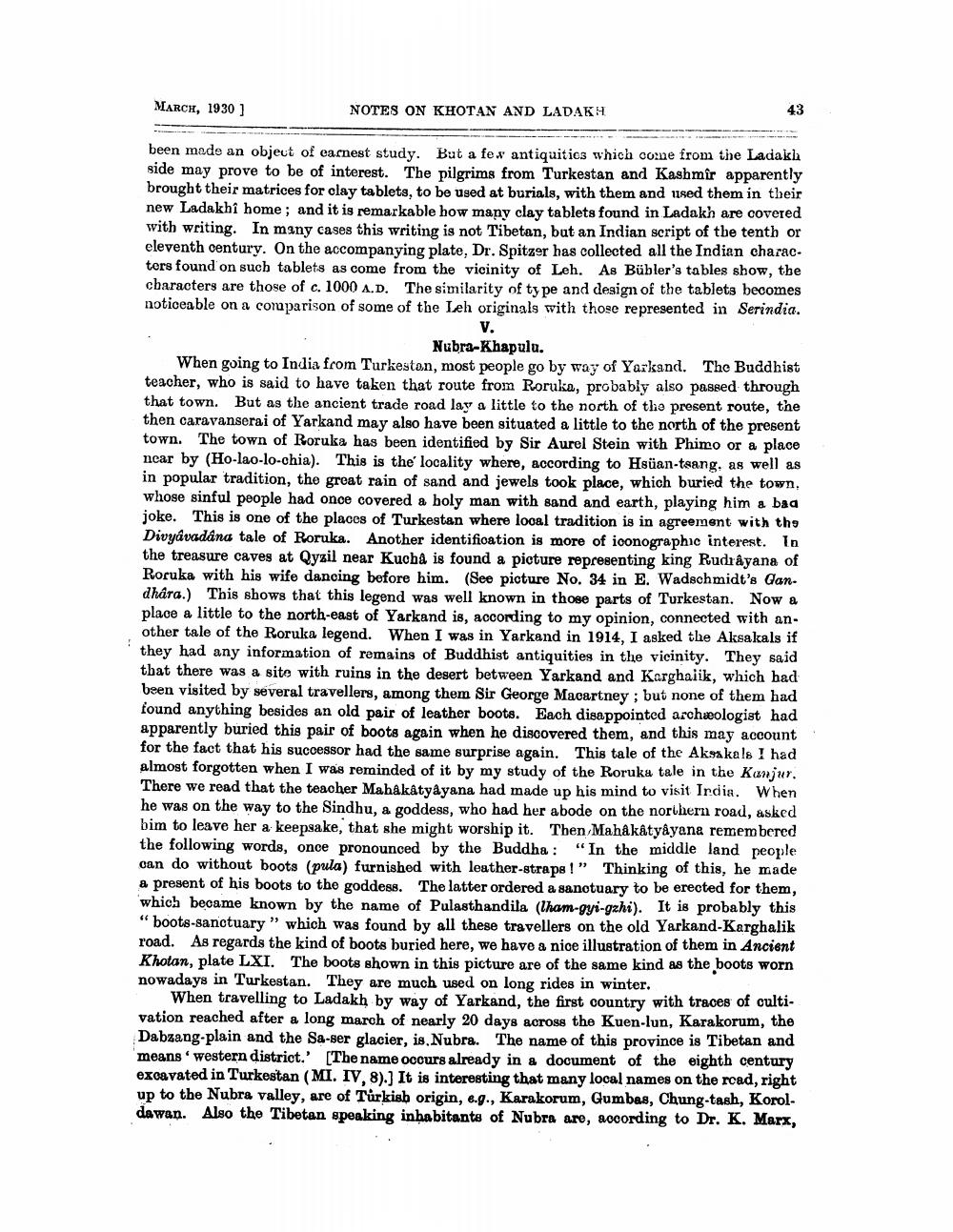________________
MARCH, 1930 ]
NOTES ON KHOTAN AND LADAKH
43
been made an object of eacnest study. But a fex antiquitios which come from the Ladakla side may prove to be of interest. The pilgrims from Turkestan and Kashmir apparently brought their matrices for clay tablets, to be used at burials, with them and used them in their new Ladakhî home; and it is remarkable how many clay tablets found in Ladakh are covered with writing. In many cases this writing is not Tibetan, but an Indian script of the tenth or eleventh century. On the accompanying plate, Dr. Spitzer has collected all the Indian charac. ters found on such tablets as come from the vicinity of Leh. As Bübler's tables show, the characters are those of c. 1000 A.D. The similarity of type and design of the tablets becomes noticeable on a comparison of some of the Leh originals with those represented in Serindia.
V.
Nubra-Khapulu. When going to India from Turkeston, most people go by way of Yarkand. The Buddhist teacher, who is said to have taken that route from Roruka, probably also passed through that town. But as the ancient trade road lay a little to the north of the present route, the then caravanserai of Yarkand may also have been situated a little to the north of the present town. The town of Roruka has been identified by Sir Aurel Stein with Phimo or a place near by (Ho-lao-lo-chia). This is the locality where, according to Heüan-teang, as well as in popular tradition, the great rain of sand and jewels took place, which buried the town, whose sinful people had once covered a boly man with sand and earth, playing him a baa joke. This is one of the places of Turkestan where looal tradition is in agreement with the Divyávadana tale of Roruka. Another identification is more of iconographic interest. In the treasure caves at Qyzil near Kucba is found a picture representing king Rudrayana of Roruka with his wife dancing before him. (See picture No. 34 in E. Wadschmidt's Gan. dhára.) This shows that this legend was well known in those parts of Turkestan. Now a place a little to the north-east of Yarkand is, according to my opinion, connected with another tale of the Roruka legend. When I was in Yarkand in 1914, I asked the Aksakals if they had any information of remains of Buddhist antiquities in the vicinity. They said that there was a sito with ruins in the desert between Yarkand and Karghaiik, which had been visited by several travellers, among them Sir George Macartney; but none of them had found anything besides an old pair of leather boots. Each disappointed archæologist had apparently buried this pair of boots again when he discovered them, and this may account for the fact that his successor had the same surprise again. This tale of the Aksakals I had almost forgotten when I was reminded of it by my study of the Roruka tale in the Kanjur. There we read that the teacher Mahâkâtyâyana had made up his mind to visit Irdia. When he was on the way to the Sindhu, a goddess, who had her abode on the northern road, asked bim to leave her a keepsake, that she might worship it. Then Mahákatyayana remembered the following words, once pronounced by the Buddha: "In the middle land people can do without boots (pula) furnished with leather-straps !” Thinking of this, he made a present of his boots to the goddess. The latter ordered a sanotuary to be erected for them, which became known by the name of Pulasthandila (lham-gyi-gzhi). It is probably this “boots-sanctuary” which was found by all these travellers on the old Yarkand-Karghalik road. As regards the kind of boots buried here, we have a nice illustration of them in Ancient Khotan, plate LXI. The boots shown in this picture are of the same kind as the boots worn nowadays in Turkestan. They are much used on long rides in winter.
When travelling to Ladakh by way of Yarkand, the first country with traces of cultivation reached after a long march of nearly 20 days across the Kuen-lun, Karakorum, the Dabzang plain and the Sa-ser glacier, is, Nubra. The name of this province is Tibetan and means western district." (The name occurs already in a document of the eighth century excavated in Turkestan (MI. IV. 8).] It is interesting that many local names on the road, right up to the Nubra valley, are of Turkish origin, e.g., Karakorum, Gumbas, Chung-tash, Koroldawan. Also the Tibetan speaking inhabitants of Nubra are, according to Dr. K. Marx,




